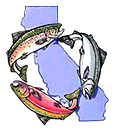Wednesday, February 19th
9:00 a.m. Welcome and Outline of the Day
Dana Stolzman, Mike Love, Ross Taylor
9:10 a.m. Primer on Fish Passage Design Approaches: Mike Love
- Spectrum of fish passage approaches
- Walk through simple stream simulation design
9:30 a.m. Aquatic Species and Stream Crossings: Ross Taylor
- Aquatic organisms of concern in California’s coastal streams
- Characteristics of instream structures that block fish movement
- Impacts of fragmenting populations
- Ecological continuity of stream channels
- Fish swimming abilities and requirements
- Ranking and prioritization of barriers for treatments
- Reasons for implementing fish passage projects and
- Fish passage resources
10:30 a.m. BREAK
10:45 a.m. “What makes a successful stream crossing project?” Group Input lead by Ross Taylor
11:00 a.m. Assessing Geomorphic Risks for Stream Crossing Projects: Mike Love
- Causes of perched culverts; plunge pool vs. incision
- Causes and impacts of channel incision
- Risk assessments for channel incision with stream crossing projects
- Placing stream crossings in aggraded channels
11:30 a.m. Neefus Gulch Channel Profile Analysis - Part 1 Exercise
- Identify stable slope segments and knickpoints
- Estimate degree of incision (vertical offsets) at each knickpoint
12:00 p.m. Lunch
1:00 p.m. Pre-design & Project Layout: Mike Love
- Hydraulic verses Geomorphic design approaches
- Site assessment overview
- Project alignment and project profile
- Determining Vertical Adjustment Profiles (VAP)
- Selecting a design approach
1:45 p.m. NOAA Fisheries Fish Passage Guidance and Criteria; Emily Thomas, Hydraulic Engineer
- NOAA Fisheries West Coast Region Fish Passage Guidelines
2:15 p.m. BREAK
2:30 p.m. Neefus Gulch Channel Profile Analysis – Part 2 Exercise
- Set low and high VAP profiles
- Set a project profile at crossing
- Show final project designs
3:00 p.m. Stream Simulation Design: Mike Love
- Overarching principals of stream simulation
- Where it is/is not applicable
- Stream simulation design process
- Project profile for stream simulation
- Suitable reference reach
- Bed design – bed materials, shape, thickness
- Banklines, key features
- Selecting crossing structure type and size
3:50 p.m. BREAK
4:05 p.m. Local Fish Passage Projects and Field Tour Teaser;Mauricio Gomez, South Coast Habitat Restoration, and Tim Robinson, Cachuma Operation and Maintenance Board
4:50 p.m. Field Tour Logistics
5:00 p.m. Adjourn
Thursday, February 20th
9:00 a.m. Depart from Mar Monte Hotel Parking Lot
- Bradbury Dam Overlook
- Quiota Creek Crossings
12:15 p.m. Lunch at River Park, San Ynez River, Lompoc
- Salispuedes Creek at Highway 1 and Jalama Road
- El Jaro Creek at Rancho San Julian
- Arroyo Honda Creek
4:30 p.m. Return to Mar Monte Hotel Parking Lot
Friday, February 21st
9:00 a.m. Stream Simulation Design – Continued: Mike Love
- Stability/mobility analysis for stream simulation culverts
- Construction techniques
9:30 p.m. Nickerson Creek Tributary Stream Simulation Design Exercise
- Section A – Interpret geomorphic site data
- Section B – Design profile and alignment
- Section C - Design streambed shape and material mixture
- Sections D and E – Optional
10:15 a.m. BREAK
10:30 a.m. Overview of Hydraulic Designs for Stream Crossings: Mike Love
- Fishway with stream crossings
- Fish baffles in culverts
- Types, applications, and limitations
10:50 a.m. CDFW Guidance on Fish Passage and Stream Restoration; Kristine Pepper, CFDW Senior Hydraulic Engineer
- Fish Bulletin 183: Log & Boulder Weirs
- Fish Bulletin 184: Large Wood in Stream Habitat Restoration
- Fish Bulletin 185: Low-Tech Process-Based Stream Restoration
11:20 a.m. Geomorphic-Based Profile Control Techniques: Mike Love
- Applications
- Geomorphic based roughened channels
- Basis of approach
- Types and applications
- Design process and construction techniques
12:00 p.m. Lunch
1:00 p.m. Geomorphic-Based Profile Control Techniques – Continued: Mike Love
- Drop structure types (boulder, log, concrete weirs)
- Shape, spacing, slope, and stability
- Design Process
1:30 p.m. Monitoring and Adaptation: Ross Taylor
- Questions that monitoring should answer
- Monitoring techniques
- Examples of previous fish passage monitoring
2:30 p.m. BREAK
2:45 p.m. Traditional Hydraulic Designs for Stream Crossings: Mike Love
- Fishways with stream crossings
- Fish baffles in culverts
- Types, applications and limitations
3:30 p.m. BREAK
3:45 p.m. South Coast Fish Passage Projects: Opportunities and Challenges; Sandra Jacobson, California Trout South Coast Region Director
4:15 p.m. Adjourn
